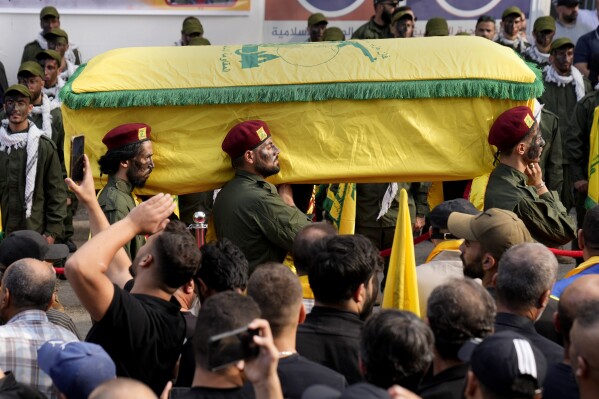BEIRUT, Oct 31 (Reuters) – With dozens of Hezbollah fighters killed in three weeks of border clashes with Israel, the Lebanese group is working to stem its losses as it prepares for the possibility of a drawn-out conflict, three sources familiar with its thinking said.
The Iran-backed group has lost 47 fighters to Israeli strikes at Lebanon’s frontier since its Palestinian ally Hamas and Israel went to war on Oct. 7 – about a fifth of the number killed in a full-scale war between Hezbollah and Israel in 2006.
With most of its fighters killed in Israeli drone strikes, Hezbollah has unveiled its surface-to-air missile capability for the first time, declaring on Sunday it downed an Israeli drone. The missiles are part of an increasingly potent arsenal.
The Israeli military has not commented on Sunday’s reported drone incident. But Israel said on Saturday it had stopped a surface-to-air missile fired from Lebanon at one of its drones and that it responded by striking the launch site.
One of the sources familiar with Hezbollah’s thinking told Reuters that the use of anti-aircraft missiles was one of several steps taken by the Shi’ite Muslim group to curb its losses and counter Israeli drones, which have picked off its fighters in the rocky terrain and olive groves along the border.
Hezbollah had made “arrangements to reduce the number of martyrs”, the source said, without offering further details.
Hezbollah leader Hassan Nasrallah is due to deliver a speech on Friday, in what will be his first address since the Israel-Hamas war erupted.
Since the Gaza conflict flared, Hezbollah’s attacks have been calibrated to contain clashes to the border zone, even as it has indicated a readiness for all-out war if necessary, sources familiar with its thinking say.
Israel, which is waging a war in the Gaza Strip that it says aims to destroy Hamas, has said it has no interest in a conflict on its northern frontier with Lebanon, where it has said so far that seven of its soldiers have been killed.
“I hope we will be able to keep quiet on this front,” Israeli Defense Minister Yoav Gallant told a briefing, adding that he believed Israel’s strong defense forces and their actions in Gaza had deterred Hezbollah till now.
Israeli Prime Minister Benjamin Netanyahu has said Israel would unleash devastation on Lebanon if a war did start.
FORMIDABLE FORCE
Hezbollah, the most formidable Iranian ally in Tehran’s “Axis of Resistance”, has long said it has expanded its arsenal since 2006 and warned Israel that its forces pose a more potent threat than before. It says its armory now includes drones and rockets that can hit all parts of Israel.
In border clashes since Oct. 7, Hamas, which also has operatives in Lebanon, and a Lebanese Sunni Islamist faction Jama’a Islamiya have both fired rockets from southern Lebanon into Israel.
Hezbollah itself has refrained from firing rockets, such as unguided Katyushas and others that can fly deep into Israeli territory, a step that could prompt an escalation.
Instead, its fighters have been firing at visible targets across the frontier with Israel, using weapons such as guided anti-tank Kornet missiles, a weapon the group used extensively in 2006, the three sources said.
Hezbollah’s television channel, Al-Manar, has regularly replayed footage from the latest clashes showing what it says are strikes on Israeli military installations and positions visible across the border.
While Hezbollah’s tactics so far have helped contain the conflict, the attacks mean its fighters need to be close to the frontier, which makes them more vulnerable to Israel’s military.
The sources said some fighters had also underestimated the drone threat after years of combat in Syria where they had fought insurgent groups with nothing like the Israeli military’s hardware. Hezbollah played a decisive role in helping President Bashar al-Assad beat back Syrian insurgents.
“The technical superiority of the Israeli drones is making Hezbollah pay the price of this number of fighters,” Nabil Boumonsef, deputy editor-in-chief at Lebanon’s Annahar newspaper, said, in reference to Hezbollah’s hefty death toll.
CONFLICT CONTAINED SO FAR
Clashes between Israel and Hezbollah have broadly stayed contained in a narrow band of land that runs along the border, generally staying within three to four km of the frontier.
However, Israeli shelling has expanded in recent days, according to security sources in Lebanon. They said this included a strike on Saturday on Jabal Safi, a mountainous area that lies about 25 km (15 miles) from the border.
The Israeli army did not immediately respond to requests for comment on the Jabal Safi strike. Hezbollah has not commented on the reports of that strike either. The Israeli army has said it has been responding to sources of fire in Lebanon.
Hezbollah lost 263 fighters in the 2006 war when Israel hit sites all over Lebanon during a more than month-long conflict. The war erupted after Hezbollah launched a raid into Israel and kidnapped two Israeli soldiers.
The Hezbollah death toll of 47 this time, in such a relatively contained conflict, has shocked the group’s supporters. The group’s al-Manar television has broadcast daily funerals of fallen fighters being buried with military honors, their coffins covered in the group’s yellow and green flag.
Hezbollah released a handwritten letter from its leader Nasrallah to the media last week, saying the fallen fighters should be called “martyrs on the road to Jerusalem”.
REUTERS

Leave a Reply
You must be logged in to post a comment.